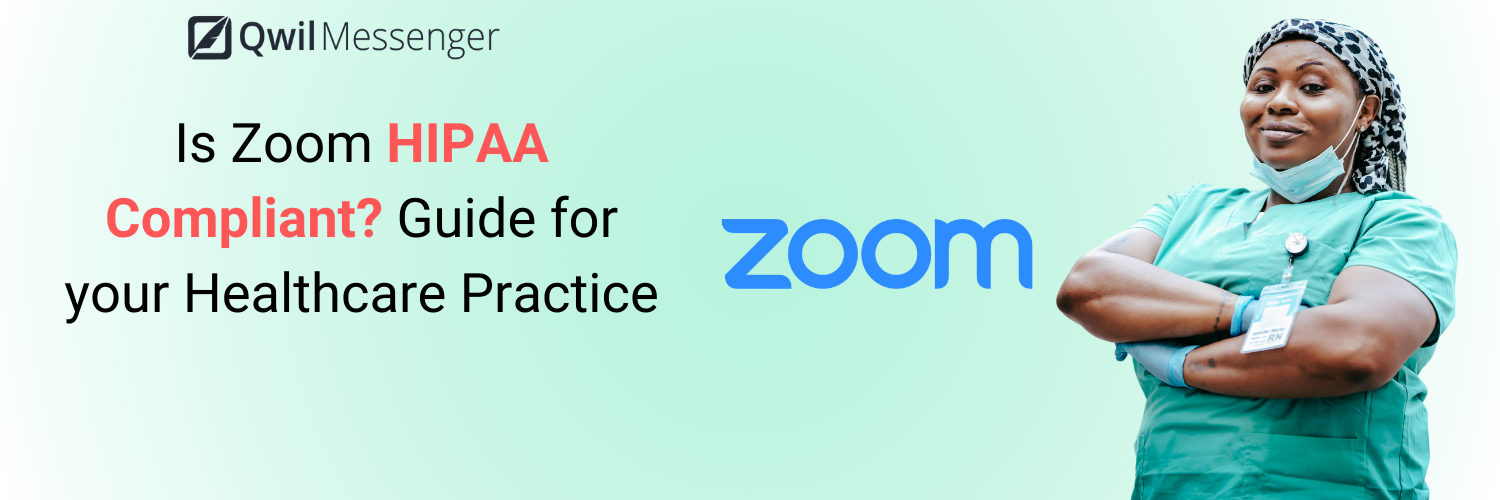Is Zoom HIPAA Compliant? A guide to HIPAA compliant Video Meetings

Let's Talk About HIPAA (and Why It Matters)
If you work in healthcare, you’ve probably heard the word HIPAA more times than you can count. But just in case, let’s break it down.
HIPAA stands for the Health Insurance Portability and Accountability Act. It’s a fancy name for a law that’s actually super important—it protects patient health information , also called PHI (Protected Health Information). Think names, medical records, diagnoses, lab results... basically anything that connects a person to their health data.
So, why does this matter? Well, if you’re handling PHI—even if it's just sending a quick message or hopping on a video call—you’re responsible for keeping that info private and secure .
And so that’s where the whole “is Zoom HIPAA compliant?” question comes in.
So, Is Zoom Safe for Healthcare?
Zoom is one of the most popular video conferencing tools out there. Lots of people use it—especially since telehealth really took off. But just because something is popular doesn’t mean it’s always safe to use with patient info.
Here’s the thing: Zoom can be HIPAA compliant—but only if you use the right version and set it up correctly.
Sounds simple? Not exactly. Let’s dig into the details.
Zoom Security Features: What’s Under the Hood?
Zoom does offer some decent security tools. For example:
-
End-to-End Encryption – This helps keep calls private from start to finish.
-
Access Controls – You can choose who gets in and who stays out.
-
Waiting Rooms – Patients can’t just pop in on a call without you letting them in.
-
Secure Messaging – There’s a chat feature, but only in certain versions.
-
Screen Sharing Controls – You’re in charge of what gets shown.
Now, here’s the catch. These features aren’t always turned on by default. So, if you’re using plain old Zoom without adjusting any settings, you could be putting PHI at risk—without even realizing it.
What About Zoom for Healthcare?
Zoom offers a special version called Zoom for Healthcare . This one is built with HIPAA compliance in mind. It comes with the tools we just talked about, plus a few more features so that it can make it easier for providers to stay compliant.
But even this “healthcare-ready” version isn’t magic. You still have to:
-
Sign a Business Associate Agreement (BAA) with Zoom
-
Configure your settings for maximum security
-
Train your staff to use it correctly
If any of that slips through the cracks, you’re back to square one with HIPAA compliance.
Why the BAA Is a Big Deal
A Business Associate Agreement (BAA) is a legal must-have if you’re using a third-party platform like Zoom to handle PHI.
Without a signed BAA, Zoom isn’t taking any legal responsibility to keep your data safe. And then what if something goes wrong? That’s on you.
When you sign a BAA with Zoom, they agree to follow strict rules for protecting PHI. That means adding:
-
Physical Safeguards – like controlling who has access to servers.
-
Technical Safeguards – like encryption and secure logins.
-
Administrative Safeguards – like internal policies and employee training.
So yes, a BAA is absolutely essential.
At Qwil Messenger , we make this easy. We always provide a signed BAA to our clients. You never have to chase us down for it, and you can rest easy knowing that your communications are covered from day one.
Still Wondering What the BAA Covers?
We get it—it sounds like a lot of legal stuff. But the BAA actually breaks down into simple responsibilities:
-
Zoom promises to protect PHI using security tools and policies.
-
You promise to use the platform the right way —like setting strong passwords and not sharing links carelessly.
-
Both sides agree to report any data breaches right away.
If you’re using Zoom without a BAA in place, it doesn’t matter how secure the platform is—you’re not HIPAA compliant. That’s the bottom line.
Okay, So How Do I Stay Compliant?
Good question. To stay compliant while using Zoom (or really any platform), you’ll need to:
-
Use Zoom for Healthcare
-
Sign the BAA
-
Enable all the right settings (like waiting rooms and access controls)
-
Train your staff on HIPAA rules and platform features
-
Regularly review and update your setup
If that sounds like a lot… well, it is. And if anything gets skipped or misconfigured, your patient data could be at risk.
So that's why many healthcare providers are switching to platforms that are secure by default—like Qwil Messenger.
What’s the HIPAA Privacy Rule Got to Do With It?
The HIPAA Privacy Rule is another big part of staying compliant. This rule says healthcare providers must protect how PHI is used, disclosed, and accessed .
However this doesn’t just apply to documents or phone calls—it also applies to video calls, too.
So, if you’re using Zoom for things like virtual appointments, follow-ups, or even patient check-ins, you need to make sure:
-
You’re using the right version of Zoom
-
Your patients know how zoom uses their data
-
You’re logging and documenting all the right info
And again, this is where it can get tricky—because just one little mistake could lead to a violation.
Is Zoom Worth the Risk?
Here’s the honest truth: Zoom isn’t a bad tool , but zoom didn't built it for healthcare. Even their healthcare version feels like a band-aid solution in some ways.
You need a platform that’s built from the ground up so that you meet HIPAA standards.
That’s where Qwil Messenger comes in. We’re not just a messaging app—we’re a secure, HIPAA-compliant communication platform . Which we built specifically for professionals who take privacy seriously.
Qwil vs. Zoom: How We Compare
Let’s break it down in a quick table:
|
Feature |
Zoom for Healthcare |
Qwil Messenger |
|
End-to-End Encryption |
✅ |
✅ |
|
Business Associate Agreement |
✅ (on request) |
✅ (always) |
|
Configured for Compliance |
❌ (needs setup) |
✅ (default) |
|
Messaging & Video |
✅ |
✅ |
|
Easy for Patients to Use |
❌ |
✅ |
|
Built for Healthcare |
❌ (adapted) |
✅ (purpose-built) |
At Qwil, we’ve removed the guesswork. This means you don’t have to figure out settings or chase down legal docs—we do it all for you.
What Should Providers Do Now?
So if you’re using Zoom—or thinking about using it—ask yourself:
-
Have I signed a BAA?
-
Are all my settings locked down for security?
-
Is my team trained on HIPAA-compliant communication?
-
Am I confident my patients’ data is truly protected?
Now if the answer to any of those is “no” or “I’m not sure,” it’s time to switch to something more secure.
Final Thoughts: The Safer Way to Communicate
Let’s be real—Zoom can work for healthcare, but it takes a lot of effort and setup. And even then, it’s not always foolproof.
We built Qwil Messenger for secure, compliant communication. We give you everything you need to protect PHI and stay HIPAA compliant—without the stress.
You also don't have to worry about switching between tools for different things. Send messages, documents, host video calls and even send e-signatures all in one place. All in full security and HIPAA compliance.
So, if you’re ready to leave the Zoom guesswork behind and switch to a platform that’s built for healthcare from the ground up, Qwil Messenger is here to help.
Let’s protect your patients’ privacy—together.
Are you a healthcare provider looking for the best HIPAA Compliant messaging software? Get your Qwil free trial here
